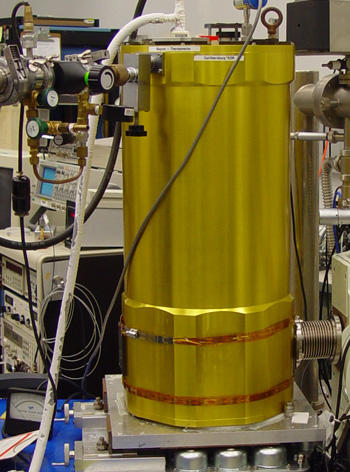Microcalorimeter Detector

The NIST transition edge sensor microcalorimeter is energy dispersive x-ray spectrometer capable of ~5 eV resolution over a range of energies from hundreds to eV to 8 keV. Calorimeters measure the thermal energy deposited in a block of normal (non-superconducting) metal by individual x-ray photons. The NIST microcalorimeter uses a block of bismuth as the sensor. The heat pulse is converted to an electronic signal through a chain of superconducting elements. A superconducting bimetal junction mounted under the sensing block is held at the temperature at which the superconductor starts to go normal. At this temperature small changes in temperature lead to large changes in the resistance of the junction. The resistance is monitored by a multistage superconducting quantum interference device (SQUID) amplifier. The resulting voltage pulses are digitized and processed using a optimal filter to extract measurements of individual x-ray photon energies. The NIST microcalorimeter is capable of output count rates of a few hundred x-rays per second. The sensor must be held at sub-liquid helium temperatures (~150 mK) to balance the junction on the normal/superconducting edge and to minimize thermal contributions to the noise budget. The system is cooled in three steps. An outer jacket is filled with liquid nitrogen and an inner jacket contains liquid helium bringing the device down to a stable temperature of 4.2 K. The device is further cooled using an adiabatic demagnetization refrigerator and the temperature actively stabilized around 150 mK for durations of six to ten hours.
Specifications/Capabilities
- Mounted on a JEOL 840
- Resolution – up to 4.4 eV
- Energies – hundreds of eV to 8 keV
- Count rates – hundreds of x-rays per second
Usage Information
Access Information
Contact Terrance Jach

